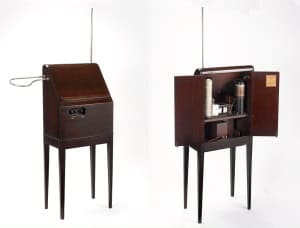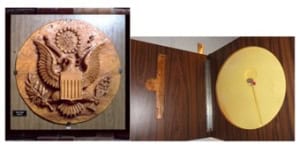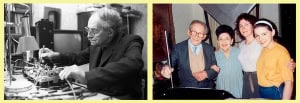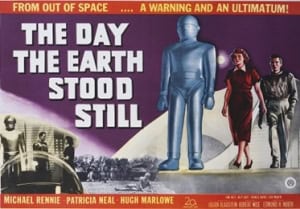The Theremin and the Birth of Electronic Music
Leon Theremin: Inventor, Musician, Spy
By George Yates
In a 2015 Guardian article, Sean Michaels quipped “In my experience, there are two kinds of people: those who are beguiled by the theremin and those who just haven’t heard of it yet.”
The music
Even if you’re not familiar with the theremin, chances are you’ve heard it on more than one occasion. Some, on a first exposure think, they are hearing a female soprano. Others have noted that the tonal sounds produced by a theremin have a violin like quality.
Compare Puccini’s O Mio Babbino Caro on a theremin (Katica Illényi : https://youtu.be/sh4EQFVAE04) and on a Stradivarius violin (Joshua Bell: https://youtu.be/DsPXig69g2A).
Many celebratory festivals were held worldwide in 2020 on the 100th anniversary of Leon Theremin’s invention. Theremin 100: Electronic Music Written for the Theremin is a link to a collection of contemporary thereminists released in 2020.
I often listen to Music Choice on Spectrum channel 1950. Theremin pieces are played on occasion; one piece played with some regularity is a haunting and beautiful version of Summertime performed by Clara Rockmore: https://www.youtube.com/watch?v=Kga4WmDVmrQ.
The man
Leon Theremin (born Lev Sergeivich Teremen in 1896) had degrees in both physics and cello performance, which certainly contributed to his invention.
The invention
In 1920, Leon Theremin was heading the experimental electronic oscillation laboratory at the Physical Technical Institute of Leningrad [St. Petersburg]. He invented a number of devices, including a high-frequency oscillator that correlated its frequency with the dielectric constant of a gas. The device emitted a tone that changed pitch as the gas density changed. Theremin noted that the output changed tone when he “interfered” with its electric field. Many accounts describe this as an accidental discovery, I’ll posit that Theremin very quickly intuited what he had uncovered. Using the control learned as a cello player Theremin managed to play a simple tune with the device and based on the delight of his coworkers, decided to develop it into a musical instrument.

Leon Theremin playing his invention, Paris in 1927.
The Theremin is played without physically touching it. By interrupting electromagnetic fields between two antennas attached to the instrument, the player controls the pitch and volume of the instrument, creating what some consider eerie and ethereal music.
The iconic theremin joke:
I think I’m going to sell my theremin; I haven’t touched it in ages…

Front and rear views of an early model of the theremin.
See Leon playing Do not scold me, my darling by Alexander Dubuque:
https://youtu.be/w5qf9O6c20 (1954).
The history
After developing a working prototype, Theremin displayed the instrument at an electronics conference in Moscow where it was so well received that he started touring with the device leading to a 1922 demonstration of the instrument to Vladimir Lenin.
Lenin was eager to show the world the advances that Soviet scientists had made, and Theremin was invited to participate in an international publicity tour. He arrived in western Europe with his theremin in the summer of 1927, giving lectures and demonstrations in Berlin, Paris, and London. In Berlin, Albert Einstein was in the audience.
Continuing his tour, Theremin arrived in New York City in December 1927 to demonstrate his invention and also to engage in a bit of industrial espionage, thus beginning his 11-year U.S. visit.
He had his first public performance of the theremin in the ballroom of the Plaza Hotel in late January 1928. Attending were Arturo Toscanini and pianist Sergei Rachmaninoff. Leon intended to stay for only 6 months, but through continuous extension of his visa ended up remaining here for 11 years.
Soon after arriving, Theremin moved into a home on West 54th Street in New York City that became a magnet for composers and scientists alike. Visitors were exposed to some of Theremin’s inventions which included an array of new musical instruments, an automatic door opener and even a color television.
Theremin gave Einstein a room at the house for exploring the connection between music and geometry, and in 1931 Theremin designed for Einstein the rhythmicon – a musical instrument that could reproduce patterns through a projector.
During this period Theremin met Clara Reisenberg Rockmore, a Russian émigré and renowned violinist, and he taught her how to play the theremin. Clara gained fame with her public performances and went on to become the best Theremin virtuoso of her time.
Prior to her marriage to attorney Robert Rockmore, Leon proposed marriage to Clara, which she declined. However, they stayed friends, and worked together to custom-build Rockmore a theremin to her size and aesthetic specifications. This instrument is used in this video of Clara playing “The Swan” (Saint-Saëns): https://youtu.be/pSzTPGlNa5U. It can now be seen at the Museum of Musical Instruments in Scottsdale, AZ.
Intrigue
Theremin’s stay in the US proved very beneficial for him. He was able to patent many of his inventions, including the 1928 patent for the theremin. By submitting his patents and befriending other inventors, Theremin was given access to sensitive documents and trade secrets, information that he sent back to Russia. He also negotiated a contract with RCA to mass produce his instrument.
Apparently, Leon was more of a scientist than a spy. Many of his inventions were patented here. He developed sensing instruments for US aircraft, touchless effects for sales windows, for Sing Sing Prison he created the world’s first electronic security system and the first weapon [metal] detectors at Alcatraz prison.
In 1936, he married Lavinia Williams, a noted member of the American Negro Ballet and was promptly ostracized by many, but not all, in his social set. In September 1938 Theremin returned to Russia, and Lavinia never saw him again. There are conflicting accounts regarding his repatriation. In an 1989 interview Leon states that he wished to return to Russia to help with the war effort.
He worked in a lab run by the Ministry of Internal Affairs developing listening tools and bugging devices to be used by the secret police. One device was used to spy on foreign embassies – and even on Stalin’s office.
Theremin created “the Thing” a transmitting device that was concealed in a replica of the Great Seal of the United States. In 1945 it was presented by Soviet school children, as a gesture of friendship for being an ally during World War II, to the US Ambassador, Averell Harriman. The Great Seal hung in the ambassador’s office, in the U.S. embassy in Moscow, transmitting confidential conversations for seven years until it was discovered and removed in 1952.

Left: An outside view of the Great Seal bug. Right: A replica of what the Great Seal bug looked like when opened.
Leon worked in this laboratory until 1966 when he was released from his duties to the State and was free to live out his life. He worked first at the Moscow Conservatory of Music, then as a professor of physics (Acoustics) at Moscow State University. He continued to build theremins and train musicians in the playing of the instrument. Theremin’s last pupil was his grand niece Lydia Kavina, who is now considered one of the best Theremin players in the world.
Conclusion
Theremin returned to the West for the first time in 51 years in 1989. In France, he gave an interview covering both his personal and professional life (https://www.thereminvox.com/stories/people/an-interview-with-leon-theremin/).
Theremin died in 1993, but not before returning once more to the United States where he was able to reunite with his first protégée, Clara Rockmore, and the other people from the life he was forced to leave behind.

Left: Leon Theremin in his lab. Igor Boyko/Sputnik.
Right: l-r: Leon Theremin, Clara Rockmore (a theremin’s performer), Theremin’s daughter Natalia, and granddaughter Olga, New-York, 1991. Personal archive of Peter Theremin
Theramin’s legacy
General U.S. interest in the theremin waned after Leon’s departure, but the theremins’ long history in movie music had already begun with its use in the 1935 horror classic The Bride of Frankenstein. Due to its characteristic sounds, it has been used as a soundtrack in many horror and science fiction movies.

Bela Lugosi plays the theremin
In 1945 Alfred Hitchcock used the theremin in his film Spellbound. The composer hired was Miklos Rosza, and he won an Oscar for best soundtrack. Rosza hired thereminist Dr. Samuel Hoffman (a podiatrist) to perform his composition. Hitchcock had two “precise requirements,” Rózsa recalled: “a big sweeping love theme for Ingrid Bergman and Gregory Peck, and a ‘new sound’ for the paranoia which formed the subject of the picture.” Hear Katica Illenyi –playing “Spellbound” at https://youtu.be/hpzZP4Va8d8.
The sound of the theremin did not yet evoke space, parallel dimensions, or an alien invasion: it was simply mysterious and suitable for building the suspenseful atmosphere Hitchcock was looking for.
Through the 1950s, Hoffman and his theremin became the sound of science fiction movies, notably The Day The Earth Stood Still, released in 1951.

The Day the Earth Stood Still – Movie poster
The Day the Earth Stood Still – “Prelude and outer space” performed on the theremin: https://youtu.be/5VQgImg15sQ
Leon Theremin’s musical legacy is enduring. The Theremin is still produced today, and its use moved into mainstream music and profoundly influenced the development of modern electronic music.
In https://youtu.be/WhR2e9ab-Uw, Leon Theremin, plays the Henderson-Vallée jazz standard “Deep Night” on what appears to be a 1929 RCA Theremin. “Deep Night” was made famous by crooner Rudy Vallée, who purchased his own theremin and used one in his orchestra, the Connecticut Yankees. This performance was given in 1930.
Leon Theremin was a formative influence in the work of Robert Moog. As influential as the Moog synthesizer has been, Bob Moog’s original focus in electronic music was the theremin. In 1954, as a teenager, he began building theremins in his basement with his father, offering kits for other do-it-yourselfers. By the time Moog began to market modular synthesizers in the mid-’60s, he already had more than ten years’ experience building theremins.
“The theremin specifically, and Leon Theremin’s work in general is the biggest, fattest, most important cornerstone of the whole electronic music medium. That’s where it all began.” — Robert Moog
Let us end on a light note – two clips from The Big Bang Theory

Sheldon playing the Theremin.
- The Big Bang Theory – Sheldon playing the Theremin
- Sheldon plays Nobody Knows The Trouble I’ve Seen: https://youtu.be/NeqndFdgakE




Great, George. Many thanks.
George, what a fascinating piece you’ve put together. The sound of the the theremin is aptly described as a mix between a female soprano and a violin, but maybe even better than the sum of those two parts. The instrument was made for Puccini’s aria and Saint-Saens, “The Swan.” I was also pleasantly reminded of that hauntingly, spooky “Spellbound” theme. The history of the instrument and its creator was fascinating.
Thanks, I’ve been richly rewarded.
Dick
Thanks for a fascinating article, George. Do you know if PBS has produced any documentaries about the theramin and its history?